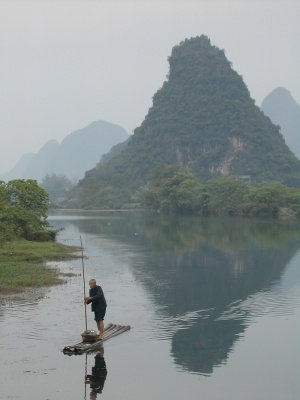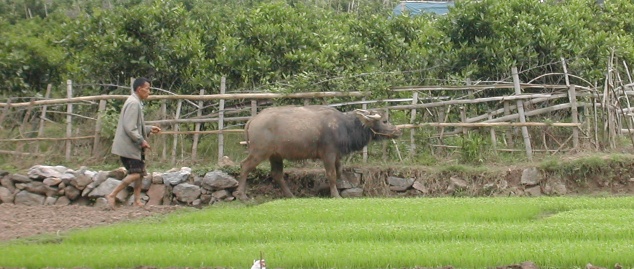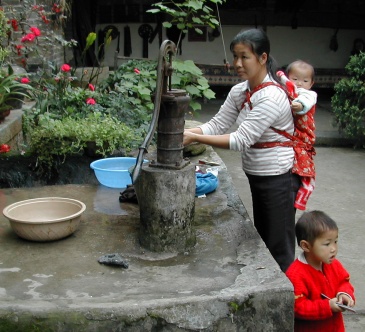YANGSHUO
Yangshuo was little more than a rural marketplace until the Li River day cruises started bringing in tourists in the late 1980s. It is still a relatively small town with a population of only 60,000, and it has retained much of its rural ambiance.
The natural scenery in and around Yangshuo is beautiful. Town has been developed around karst hills, and the farm country just outside of town is punctuated with karst as far as the eye can see. There are also numerous karst caves around Yangshuo, but we did not visit them – we visited the Reed Flute Caves outside Guilin.

Poling bamboo raft
As we arrived in Yangshuo, we saw cormorant fishermen in the water and on the shore. This unusual fishing technique has been used in China for thousands of years. Although its practice has declined throughout much of the country, it is still common in Yangshuo. Fishermen pole their rafts out – usually at night – with a light on the bow and their cormorant wearing a collar around its neck and a tether around one leg. The collar is just tight enough that the cormorant cannot swallow any fish it catches, and the tether allows it to swim/dive but not too far from the raft. The light attracts fish, and the cormorant dives and catches the fish in its bill. Although the cormorant can catch the fish, he cannot swallow it. The fisherman retrieves the cormorant and fish using the tether, and he takes the fish from the cormorant’s bill. Needless to say, the collar is removed before the night is done so that the cormorant can catch its own dinner. An interesting technique.
Those who know us know that we enjoy ourselves most when out mingling among the locals, and Yangshuo was a great place to do just that. We made the local market our first stop in Yangshu. What a ‘colorful’ place! There were fruits and veges of every local variety, and there were many animals. Some animals had been killed/butchered, but many were still alive in cages, pens, and buckets. But the market was just a prelude to the ‘night market’ which is common in many Chinese cities.
The night market is almost exclusively street food stalls with only a few other vendors. The night market in Yanghsuo had at least 20 food stalls, and each stall had a huge butane burner over which it cooked any desired combination of ingredients. We did look askance at some of the ingredients: beef tendon, pig intestine (threaded on wooden skewers), eel, frog, dog, rat. We thoroughly enjoyed roaming around the market, but we ate at the hotel.

Plowing rice paddies with water buffalo

Drawing water from the well
We also went out in to the farm country – almost all rice paddies. Here, too, the water buffalo is used exclusively for plowing. Their farming in the rural communities remains very low tech. Unfortunately, we learned that there are no – absolutely zero – controls on pesticides and chemicals that are used by farmers. So it may be low tech, but it isn’t necessarily healthy. We also learned that 10% of China’s farm land is so polluted that it is no longer arable. China’s rampant pollution is not just an urban problem.
We also got the opportunity to briefly visit with a rural family outside of town. Although there were a few memorable aspects to this visit, our first impression remains the most memorable. As we passed through the entrance to their home, there were two wooden coffins nearly completed. We did not ask for whom they were being built, but we found it odd to have two coffins-in-progress at the entrance to your home. We had visited a home in the hutong in Beijing, and it was interesting to see the difference in the rural home in a small community.
After too little time in Yangshuo, we drove the 44 miles back to Guilin. Our second stop in Guilin would precede our flight to our last destination city – Shanghai.
Follow us back to Guilin or on to Shanghai or return to our China page.